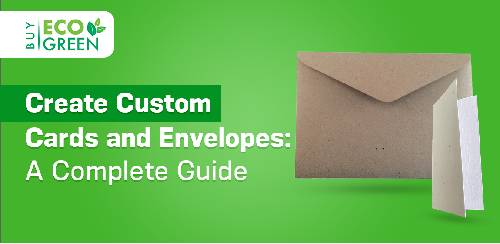


Learn how to make personalised cards and envelopes with sustainable materials. Add a creative touch to gifts, events, and business packaging.
Creating custom cards and envelopes is a rewarding way to convey heartfelt messages while reflecting your personality or brand. For Australian businesses like Buyecogreen—an eco‑friendly product supplier—handmade stationery also embodies sustainability and craft. This guide explains the materials, techniques and design ideas you need to make bespoke cards and matching envelopes. It uses insights from authoritative craft tutorials and sustainability resources to help your creations rank well in search results and resonate with readers.
Handmade cards and envelopes offer personal expression that store‑bought stationery can’t match. Whether you’re sending birthday greetings, marketing your brand or making wedding invitations, a customised design lets you choose colours, textures and messages that match the occasion. Making your own stationery is also eco-friendly: you can repurpose old cards and magazines, reuse packaging materials, and select papers made from recycled fibres or plant-based materials. By crafting your own pieces, you control the process from start to finish and avoid unnecessary plastic packaging.
Custom stationery also provides an opportunity to reinforce business identity. Companies like Buyecogreen can showcase their commitment to sustainability by using recycled card stock and water‑based adhesives, printing logos on envelopes and choosing natural finishes. This personal touch enhances brand recognition and fosters customer loyalty.
Gathering quality materials and tool sets you up for success. At a minimum, you need:
For a truly sustainable kit, look for plantable seed paper, bamboo pens and pencils, and journals made from post-consumer waste. Refilling pens and using durable tools reduces waste.
Decide on the card’s purpose—birthday, thank‑you or holiday—and select colours and motifs accordingly. For example, choose bright colours and balloon images for a birthday or earth tones and nature motifs for eco‑themed cards.
Cut your cardstock to size—5×7 inches (approximately A7) is a standard dimension, but you can choose any size that suits you. Fold the card in half using a bone folder or ruler to create a crisp crease.
Lay out images, patterned paper and die‑cuts on the front without gluing to see what works. You might cut out motifs from old cards (a thrifty way to upcycle) and glue them onto coloured mats. Use natural wood veneer embellishments or seeded paper cut-outs for texture—nluv Studio’s kits utilise cherry wood veneer and recycled card stock to highlight natural beauty. When satisfied with the arrangement, adhere everything using eco‑friendly glue or tape.
Write a heartfelt message by hand or print one on recycled paper and glue it inside. Keep the note concise and personal; simple wording is often most effective.
Enhance your card with natural elements like pressed flowers, twine or wooden cut‑outs. If you enjoy colour, use brush-tip markers to create colour blocks or add calligraphy. Oil-based paint pens can add shine to wooden elements. Still, they require longer drying times. For sparkle, apply a thin layer of glue and sprinkle fine glitter—remember to base‑coat with marker so the colour underneath shows through.
Throughout the process, choose environmentally friendly supplies. Use recycled cardstock, plant‑based inks and adhesives without harsh chemicals. Consider repurposing old cards and wrapping paper, as Aunt Annie’s tutorial on recycling cards suggests. Sustainable choices reduce waste and support Buyecogreen’s mission.

Homemade envelopes add a touch of elegance to your card. Carissa Burk’s tutorial on Creative Green Living demonstrates a simple method using any 8.5 × 11‑inch paper. Here’s an adapted version:
If you want to add a mailing label, attach a blank label or a piece of recycled paper to the front of the envelope. For a gift card, use a 5 × 7‑inch sheet and follow the same steps.
Sustainable stationery goes beyond paper. Opt for pens made from bamboo or other renewable materials; a bamboo fountain pen with water-based, non-toxic ink provides a luxurious yet eco-friendly writing experience. Plantable pencils, such as Sprout pencils, can be planted once they’re too short to use; they contain seeds in the end capsule and are made from sustainable wood. Journals made from 100% post-consumer waste and printed with vegetable-based inks offer sustainable options for notes and letters.
When choosing paper, look for FSC‑certified or recycled stock. Some stationery uses herb or plant seed paper that can be planted after use. Sustainable pens and refillable inks reduce waste. Using custom stationery sets from Buyecogreen ensures that your letters and cards align with your environmental values.
Once you’ve mastered the basics, experiment with different techniques:
Exploring techniques like stamping, die-cutting, watercolour, and interactive pop-ups can elevate your cards even further. As you experiment, remember to stay true to your eco‑friendly ethos by using sustainable inks and materials.
After creating your card and envelope, consider how you’ll present or mail them. Real Simple’s eco‑friendly gift wrapping tips emphasise avoiding plastic tape—plastic prevents paper from being recycled. Instead, use paper tapes like decorative washi, or wrap with fabric secured by twine. Natural ribbons and twine can be reused year after year. Choose recyclable tags over adhesive stickers to ensure that everything can be easily recycled and disposed of properly. Adorn your parcels with dried flowers, leaves, or acorns to add a lovely finishing touch. When shipping, protect your card in a reusable mailer or cardboard envelope rather than plastic. Buyecogreen supplies compostable sleeves and kraft boxes that keep cards safe while aligning with your environmental values.
Here are some practical suggestions to ensure your card‑making experience is enjoyable:
If you’re feeling adventurous, try advanced techniques like stamping, die-cutting, or watercolour backgrounds. You can also incorporate interactive features such as pop‑ups or shaker elements. Remember that every card you create is an opportunity to express creativity and care while reducing your environmental footprint.
Know more https://www.buyecogreen.com.au/custom-cards-and-envelopes-guide/
